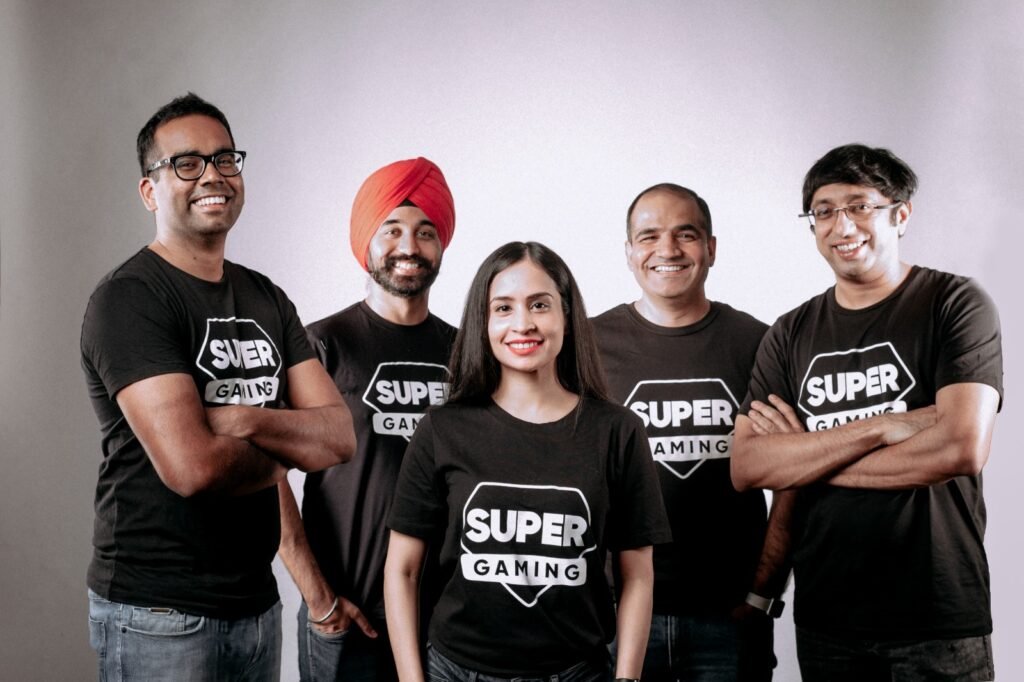An Exclusive interview with Roby John, CEO and Co-founder of SuperGaming
1. SuperGaming has positioned Indus as “India’s most ambitious game to date.” Can you walk us through the creative vision and cultural inspirations that shaped Indus, and how you see it contributing to India’s global gaming identity?
The creative vision behind Indus was clear from the start: to do for India what Black Panther did for Africa. Just as Wakanda introduced the world to Afro-Futurism, Indus introduces Indo-Futurism: a reimagining of what the Indus Valley Civilisation could have become if it had advanced into the stars instead of vanishing from history.
At its core, Indo-Futurism is a cultural reclamation. It’s about imagining an India where mythology, architecture, science, and spirit evolve side-by-side in a speculative future. Every part of Indus is designed to reflect this. From the architecture of Virlok to the names of its characters and locations.
Take Sir-Taj, for example: our tribute to the Taj Mahal, not just in name but in philosophy. He embodies majesty and timelessness, a symbol of what an eternal guardian of culture might look like in a sci-fi future. Heena is inspired by Olympic shooter Heena Sidhu, reflecting India’s real-world excellence and bringing it into a mythic battle royale. Mech-Balika is a futuristic interpretation of the traditional Rajasthani kathputli puppet—only now, she has shattered her strings and become a symbol of agency and independence. Pokhran, another Mythwalker, is named in homage to Dr. Homi Bhabha and India’s scientific legacy, tying real-world milestones into the game’s fabric.
Even the locations in Indus echo this blend of future and tradition. Jatayu Park, set in high-altitude terrain, features a towering statue of the mythic bird Jatayu and acts as a hotspot filled with lore and loot and a testament to Bravery inspired by Jatayu. Lok Terminal is a massive transport hub lost in time, hinting at ancient trade and interstellar movement. Shrine, on the other hand, reflects spiritual remnants of the past colliding with the tech-laced chaos of the present.
With Indus, we wanted to create a game that feels Indian without explanation. For us it’s not about exporting a superficial idea of India but about giving global audiences a new lens to experience it. Through visuals, names, stories, and systems that resonate with Indian players and intrigue everyone else. This is our way of contributing to India’s global gaming identity: by creating a game that only India could have imagined, and the world is invited to play.
2. SuperGaming has built a strong community even before game releases, as seen with Indus. What’s your secret to fostering such deep player engagement at such an early stage, and how does this community-first approach influence your development process?
Fostering deep player engagement before launch has been a deliberate, layered process at SuperGaming. For Indus, we structured our strategy around giving our players meaningful access, agency, and recognition from day one.
We kicked off with community playtests across India, engaging players not just in metros but in emerging gaming hubs in order to reach out to grassroots talents. These playtests offered live feedback opportunities with the developers present, which helped break down the typical studio-player barrier. This face-to-face interaction gave our devs real-time insights and players a sense of direct influence on the game’s direction.
Our community meetups reinforced this connection, bringing together creators, fans, and developers to discuss, celebrate, and shape Indus. These events were intentional spaces to gather feedback, test ideas, and build trust.
Building on that momentum, we launched our closed beta program, where access wasn’t treated like a giveaway, it was earned. Roles like “Early Access to Closed Beta” were actual rewards for community contribution and activity. Under this program, select players were given ‘Keys’ to test Indus, making participation more meaningful and giving them a real stake in development.
We also introduced a Referral Program that incentivised our community to bring their friends in. Rewarding organic word-of-mouth, which has proven to be one of our strongest channels for growth. This built a player network that was interconnected and invested.
In parallel, our Discord community became a central hub for engagement, with regular developer Q&As, lore updates, exclusive content drops, and the ability for players to vote on or even co-create aspects of the game. All of this is built on a transparent pipeline that includes the Indus Test Lab, our internal structure for incorporating community feedback into the dev roadmap.
Furthermore, with the Indus Prime Squad and Indus Insiders, we empowered multilingual, regional voices to carry the narrative forward. Today, our creators and ambassadors span all 28 Indian states.
From leaderboard shoutouts to featuring players on billboards, we’ve made it a point to ensure our community feels seen and celebrated.
The result? 100,000+ strong on Discord before launch, with players driving momentum, not just marketing. For us, community is not just a part of game development; it is game development. Every lore update, feature rollout, and system tuning passes through this lens, making the final product as much theirs as ours.
3. SuperPlatform is a powerful asset not just for SuperGaming’s own titles but also for global names like PAC-MAN. Can you tell us how this platform is shaping the future of gaming infrastructure, and what makes it attractive for third-party developers?
SuperPlatform is the result of nearly a decade of building, launching, and scaling games at SuperGaming. It powers over 10 live titles with more than 400 million installs globally. These include international IPs like Bandai Namco’s PAC-MAN and homegrown successes like MaskGun, Silly Royale, and Indus Battle Royale.
Built by game developers, for game developers, SuperPlatform is a fully integrated stack that handles everything from real-time multiplayer networking and matchmaking to live ops, progression systems, battle passes, leaderboards, commerce, and even Web3 integration. Every feature in the platform exists because we needed it for our own games and have battle-tested it in live environments.
What sets SuperPlatform apart is our integration-first approach. While other platforms focus on self-serve dashboards and generic APIs, we work directly with developers to provide custom, scalable infrastructure that fits their needs. Our tools are modular, Unity-ready, and can get your game up and running with robust backend features.
We provide tick-based netcode architecture for real-time gameplay, sophisticated segmentation for personalising content by region or behaviour, and deep analytics to iterate faster. It is already serving tens of thousands of concurrent players in production environments across multiple countries. For third-party developers, SuperPlatform offers the reliability of AAA infrastructure with the agility of a startup. Whether you are a global publisher expanding into India or a regional studio aiming for scale, SuperPlatform gives you the tools to reduce time-to-market, boost engagement, and focus on what matters most: Your Game.
In short, SuperPlatform is your live ops engine, your infrastructure partner, and your blueprint for scale in a global gaming landscape.
4. With Bandai Namco and other international players investing in SuperGaming, how do these partnerships shape your growth strategies, and what does this say about the global confidence in India’s gaming potential?
Our partnership with Bandai Namco is more than capital investment, it’s a collaboration grounded in knowledge sharing, creative alignment, and long-term guidance. Their decision to reinvest in SuperGaming validates the creative, technological, and community-driven foundation we’ve built with Indus and beyond.
This partnership strengthens our ability to scale Indus as a world-class gaming experience while continuing to invest in SuperPlatform, our proprietary tech stack that supports live-ops, telemetry, matchmaking, and real-time personalisation at scale. The collaboration enables us to learn from one of the most iconic game publishers in the world, while still staying true to our made-in-India ethos.
It also signals a broader shift in how India is perceived in the gaming industry. For decades, India was seen primarily as a service hub. That narrative is changing. Today, we’re proving that India can build original IPs, innovate at the platform level, and compete at a global scale. Bandai Namco’s backing is a clear acknowledgement of that evolution.
The impact goes beyond products and tech. It allows us to hire and retain top talent, grow our creator ecosystem, and deepen our community engagement. From studio engineers to esports organisers and regional influencers, the entire gaming value chain benefits from this vote of confidence.
In essence, these partnerships reflect not just belief in SuperGaming but belief in India as a creative and technological powerhouse. It’s a signal that Indian game development is no longer emerging; it’s here, and it’s ready to shape the future of gaming globally.
5. Balancing profitability, creativity, and community can be challenging. How has SuperGaming managed to stay profitable while still focusing on product quality and authentic storytelling without falling into the trap of ‘growth hype’?
For us, profitability was never the primary goal—we’ve raised capital from great investors not just to chase margins, but to build deep tech from India, like our own game engine and live ops platform. That said, we’ve always been disciplined. We don’t fall for growth-at-all-costs hype. Our games are built to last, with community at the heart and stories that matter. When players tell us our games have changed their lives, or when someone wears our game’s logo on their prosthetic leg, it reminds us why we do this. We’re not optimising for vanity metrics; we’re building games people care about, and that care is what drives retention, revenue, and meaning.
6. Looking ahead, what is your long-term vision for SuperGaming’s role in shaping the gaming ecosystem, not just in India but globally? What new frontiers or innovations are you most excited about?
Our big vision is for SuperGaming to be a global name that connects technology, culture, and community. We want to prove that amazing games with unique cultural flair can come from India and be loved everywhere. In the next 5-10 years, we aim to lead the way with innovative and authentic games that make the global gaming world more diverse and exciting.
We’re really excited about using advanced AI in our games and our SuperPlatform. Imagine game worlds that change based on how you play, or smart characters that learn and grow with you. AI will help us personalise your experience, whether you’re a pro or just starting out. It’ll also be like a co-developer for our team, helping us build richer worlds faster.
We also see culture as a living part of our games. With Indus, we introduced Indo-Futurism, and that’s just the beginning. We plan to keep our games fresh with events and stories inspired by real-world festivals and myths and represent cultures worldwide authentically. This way, our game worlds are always evolving, and our community can be a part of that ongoing cultural conversation.
Globally, we want to be a bridge. Our partnership with Bandai Namco is just a taste of what’s to come. We want to bring our Indian-made games to the world and bring global favourites to India with a unique twist. By teaming up with international studios, we can put India on the map as a creative force in gaming. Ultimately, we’re working towards a future where games are smarter, culturally richer, and more connected. We’re excited to explore new frontiers like AI and community co-creation. But no matter what, our focus will always be on you, the player. We want to build a future where anyone, anywhere, can feel a deep connection to the games they play. That’s the future we’re building, one game update at a time.













